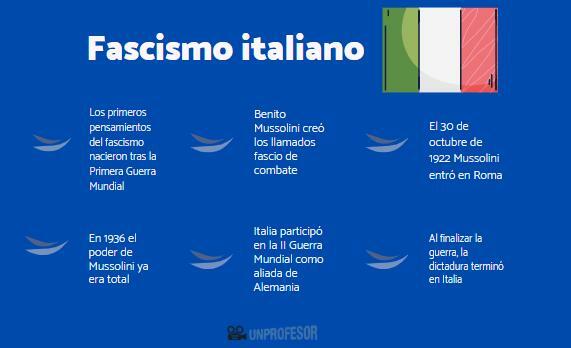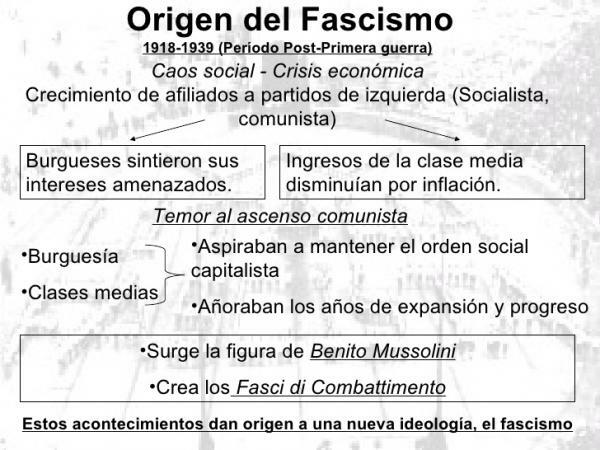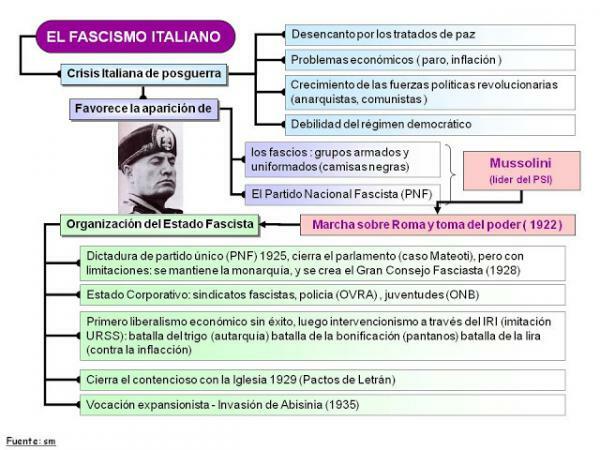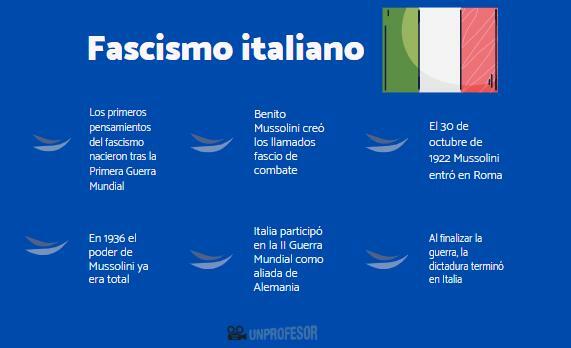Italian fascism- short SUMMARY + SCHEMES !!

The italian fascism It was a movement of great importance in the Mediterranean nation that was born as a reaction to socialism, communism and liberalism. This ideology achieved in a short time absolute power in Italy and the expansion of its thought throughout much of Italy. To comment on all this in this lesson from a TEACHER we are going to offer a summary of Italian fascism.
Index
- Origin of Italian fascism
- The beginning of the fascist dictatorship
- Italian fascism in World War II
Origin of Italian fascism.
The first thoughts of Italian fascism were born after the First World War, after which Italy fell into a hard economic and social crisis caused in part because Italy did not get great benefits from the war but did suffer great human and economic losses. In postwar Italy, propaganda began to be used to point out that Italy should have benefited the most and it was the fault of the people. conservatives and socialists, being especially important in this frustration group the ex-military men who had fought during the war Italian.
In 1919, and taking advantage of this situation, Benito Mussolinihe created the so-called combat fascio, being a group of volunteers who attacked socialists and communists and who also served as the central nucleus of the Italian Fascist Party. Thus was born a group that faced socialists and liberals and that was based on violence and extreme nationalism.
Over the years, the fascio were gaining more and more power, at the same time as Mussolini and the fascists. Coming to a point in 1922 when armed groups occupied all cities through violence and they threatened to start a civil war if they didn't let them take Rome. On October 30, 1922, a Mussolini already appointed as prime minister entered Rome with the rest of the members of the fascist party to take the city and the country by force.

Image: Slideshare
The beginning of the fascist dictatorship.
To continue with the summary of Italian fascism, we are going to continue with the beginning of the dictatorship. With the arrival of Mussolini to power it became more and more evident that what the fascist leader sought was absolute power and the end of democracy in Italy. He was given the power to govern by creating decrees without the parliament being able to vote, the black shirts or combat fascio they were named a paramilitary force of the government, he created a law that allowed him the ability to achieve great power in parliament and whose name was Acerbo.
There are many cases that show that Mussolini's government was violent and authoritarian, but without a doubt the best known case is that of Matteotti, being a socialist who openly criticized the fascist government and was kidnapped and assassinated by members of the black shirts. From that moment, the opposition left Parliament and began to act from abroad, while Mussolini created the laws that he wanted because of his great power.
Behind the end of opposition, Mussolini was increasing his power in every possible way, eliminating freedom of the press and freedom of meeting, increasing the power of the Prime Minister, this being his position, persecution of the members of other matches, creation of a political police called Ovra and he sought the end of the unions to end the class struggle.
In 1936 the power of Mussolini was already total and Italy had become a fascist dictatorship in which only one party had power and Mussolini concentrated all possible powers in his person. In this great increase in power, propaganda was very relevant, being used by the fascists to convince the population that they were good for them.

Image: Historical screen
Italian fascism in World War II.
To finish this summary of Italian fascism, we must talk about the last years of the Mussolini government, being the time in which he already had absolute power and began to carry out campaigns outside his nation, the role being especially important of Italian fascism in WWII.
The first movement of Italian fascism was look for a kind of Latin Block, Being an alliance between Italy, France, Spain and Portugal, it never came to work for various reasons. From that moment on, Italy sought to spread fascism to other nations.
Seeking an expansion of its territory Italy started the Italo-Ethiopian war, being a war between Italy and the Ethiopian empire or Abyssinia. The war was given by the search of Italian fascism to increase its influence through imperialism, and it served to bring Italy and Germany closer together.
On May 22, 1939, the Pact of Steel between Nazi Germany and fascist Italy, being governments very similar in most of their ideals, causing that in case Germany was attacked the Italian country should also participate in the conflict.
After the start of the Second World War, Italy did not dare to participate immediately, but after seeing the great German victory against France decides to participate in June 1940. Italy's participation was never too positive, with many defeats suffered and being the first of the Axis powers to lose the war.
After Mussolini's death and defeat in war, the Italian fascist government disappeared going through a hard period in which over the years Italy became a democracy again. The majority of followers of the fascists were tried and in the following elections the parties most persecuted by the fascists were those that got the most votes.

If you want to read more articles similar to Italian fascism: summary, we recommend that you enter our category of Story.

